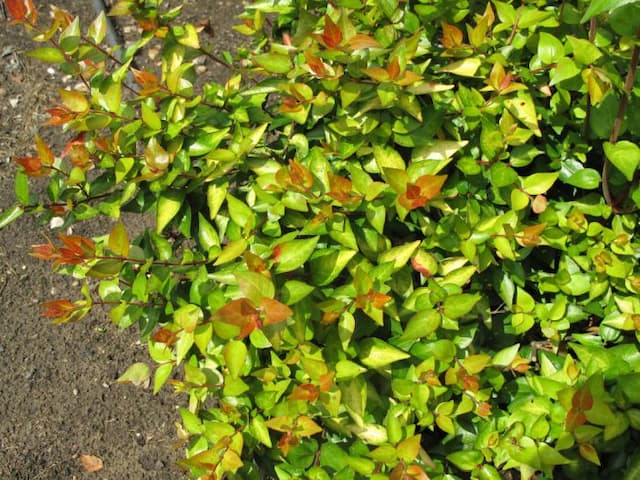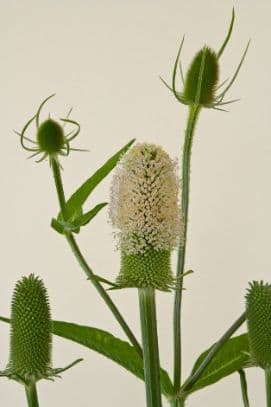Italian Honeysuckle Lonicera × italica

ABOUT
The plant known as the Italian honeysuckle has a striking appearance that can catch anyone's eye with its twining vines that gracefully intertwine and climb, creating a lush green tapestry. The leaves of the Italian honeysuckle exhibit a vibrant green that can be either deciduous or semi-evergreen depending on the climate, providing a beautiful backdrop to the flowers. These leaves are typically oval-shaped and grow opposite each other on the stem, creating a sense of symmetry and balance. The true stars of the Italian honeysuckle are its flowers, which are a magnet for garden visitors like hummingbirds and bees. The blooms are incredibly fragrant, often filling the air with a sweet aroma that can be a delight on a warm day. They are tubular in shape and usually display a striking two-tone color palette where the outside of the flowers can be a creamy white, a pale yellow, or sometimes even a light pink, while the insides are a contrasting bright yellow or gold. These blossoms dangle in pairs and are followed by small berries that can range from red to black in color. Throughout its growing season, the Italian honeysuckle remains a focal point in the garden, not only for its visual appeal but also for the sensory experience it provides with its perfumed flowers. It's no wonder that these plants are often selected to adorn trellises, walls, and fences where they can spread their charm with a cascading effect.
About this plant
 Names
NamesSynonyms
Italian Honeysuckle, Italian Woodbine
Common names
Lonicera × italica.
 Toxicity
ToxicityTo humans
The plant Lonicera × italica, commonly known as Italian Woodbine, is not typically considered highly toxic to humans. However, some Lonicera species, like other honeysuckles, contain saponins, which are mildly toxic compounds that can cause gastrointestinal issues if ingested in large quantities. Symptoms of saponin poisoning could include nausea, vomiting, diarrhea, and abdominal pain. Ingesting small quantities of the plant typically does not lead to serious health issues, but consuming significant amounts of leaves, stems, or berries should be avoided to prevent the potential for toxicity.
To pets
Italian Woodbine, or Lonicera × italica, contains saponins, which are mild toxins that can be harmful to pets if ingested in large amounts. While the plant is not highly toxic to pets, consumption of significant quantities can cause symptoms such as vomiting, diarrhea, and abdominal pain. It is advisable for pet owners to prevent their animals from ingesting parts of this plant to avoid the risk of gastrointestinal distress. If a pet does consume a large amount of Italian Woodbine, contacting a veterinarian is recommended.
 Characteristics
CharacteristicsLife cycle
Perennials
Foliage type
Deciduous
Color of leaves
Green
Flower color
Yellow
Height
10 feet (3 meters)
Spread
6 feet (1.8 meters)
Plant type
Shrub
Hardiness zones
5
Native area
Europe
Benefits
 General Benefits
General Benefits- Attractive Flowers: Lonicera × italica, commonly known as Italian Honeysuckle, produces beautiful flowers that can add aesthetic value to gardens and landscapes.
- Wildlife Attraction: The flowers attract pollinators such as bees and butterflies, which can help pollinate other plants in the vicinity.
- Scented Flowers: Italian Honeysuckle has fragrant flowers that can provide pleasant scents in the area where it's planted, creating a sensory garden experience.
- Grows in Various Conditions: It is adaptable and can grow in a range of soil types and conditions, making it a versatile choice for gardeners.
- Seasonal Interest: The plant offers seasonal interest with its blooms in spring and summer, and can retain foliage offering some greenery in other seasons depending on the climate.
- Privacy Screen: When grown as a hedge or climbing vine, Italian Honeysuckle can provide a natural privacy screen while enhancing the beauty of space.
- Erosion Control: Its roots can help stabilize the soil and prevent erosion, particularly on slopes or areas with loose soil.
- Creates Habitats: It can provide shelter and nesting sites for certain species of birds and insects, promoting local biodiversity.
- Shade Creation: When grown over arbors or pergolas, Italian Honeysuckle can create natural shaded areas, making outdoor spaces more comfortable during warmer months.
- Low Maintenance: It generally requires minimal care once established, making it a low-maintenance option for gardeners and landscapers.
 Medical Properties
Medical PropertiesThis plant is not used for medical purposes.
 Air-purifying Qualities
Air-purifying QualitiesThis plant is not specifically known for air purifying qualities.
 Other Uses
Other Uses- As a natural dye: The Lonicera × italica, commonly known as the Italian honeysuckle, can be used to produce a range of natural dyes for fabrics, owing to the pigments present in its flowers and berries.
- In perfumery: The scented flowers of Italian honeysuckle can be used in making perfumes or scented oils, imparting a sweet and enticing fragrance that is valued in the cosmetics industry.
- As an ornamental plant: Due to its attractive flowers and twining habit, the Italian honeysuckle is often planted as an ornamental vine in gardens, arbors, and on fences.
- For erosion control: The robust root system of the Italian honeysuckle can help stabilize soil on slopes and embankments, thereby controlling erosion.
- As living sculptures: Gardeners can train Italian honeysuckle vines over structures to create living sculptures or green art in their gardens.
- In crafting: The flexible vines of Italian honeysuckle can be woven into baskets, wreaths, or other decorative items.
- As a floral arrangement: Italian honeysuckle flowers can be used in floral arrangements to add a touch of beauty and a pleasing fragrance.
- In culinary use: Some cultures may use the nectar of the Italian honeysuckle to sweeten tea or as a syrup, although this is less common and should be done with caution to avoid toxic varieties.
- Wildlife support: The plant provides nectar for hummingbirds and other pollinators, and its berries can be a food source for various bird species.
- For hedge creation: The rapid growth and dense foliage of Italian honeysuckle make it suitable for creating living privacy screens or hedges in the landscape.
Interesting Facts
 Feng Shui
Feng ShuiThe Italian Honeysuckle is not used in Feng Shui practice.
 Zodiac Sign Compitability
Zodiac Sign CompitabilityThe Italian Honeysuckle is not used in astrology practice.
 Plant Symbolism
Plant Symbolism- Love: Lonicera × italica, commonly known as Italian woodbine, often symbolizes love and devotion, as honeysuckles are renowned for their sweet fragrance and the way their vines cling to structures, resembling the clinging nature of love.
- Generosity: The abundant blooms and the way it shares its sweet scent can represent the act of giving and generosity.
- Fidelity: The intertwining vines suggest steadfastness and loyalty, qualities often associated with faithfulness in relationships.
- Bonds of Friendship: Italian woodbine is thought to represent the strong, intertwined bonds of friendship, again playing on the entwined nature of its vines.
- Happiness: The sweet and intoxicating scent of the plant is said to bring joy and delight, symbolizing happiness.
 Water
WaterThe Italian Honeysuckle should be watered deeply once a week, ensuring that the soil is moist but never soggy. During hot, dry periods, water requirements may increase to twice a week. Ideally, apply about 1-2 gallons of water to the root zone, avoiding overhead watering to minimize leaf wetness and potential diseases. In winter, reduce watering to every other week or less, depending on the plant's dormancy and local weather conditions. Regularly check the soil moisture by feel, and adjust your watering schedule to maintain consistent soil moisture without waterlogging.
 Light
LightItalian Honeysuckle thrives best in full sun to partial shade, with at least 4-6 hours of direct sunlight each day. It can tolerate some shade, especially during the hottest part of the day, but will bloom more profusely in a sunnier spot. Avoid deep shade locations, as this can lead to reduced flowering and a leggy growth habit.
 Temperature
TemperatureThe Italian Honeysuckle is hardy and can withstand a range of temperatures, tolerating minimums down to 0 degrees Fahrenheit and maximums well above 100 degrees Fahrenheit. However, its ideal growing temperatures range between 60 and 80 degrees Fahrenheit. Providing some shelter from extreme winter cold or summer heat can help the plant maintain its health and vigor.
 Pruning
PruningPrune Italian Honeysuckle to maintain its shape, encourage fresh growth, and ensure prolific flowering. The best time for pruning is late winter or early spring, before new growth begins. Remove any dead, damaged, or overgrown branches, and trim back as needed to control the size and spread of the plant. Pruning can be done annually or biennially depending on the plant's performance and desired appearance.
 Cleaning
CleaningAs needed
 Soil
SoilItalian Honeysuckle thrives best in moist but well-draining soil with a pH of 5.5 to 8. A mix containing loam, sand, and organic compost is ideal to ensure proper drainage and fertility.
 Repotting
RepottingItalian Honeysuckle should be repotted every 2 to 3 years to refresh the soil and accommodate root growth. Older, well-established plants may require less frequent repotting.
 Humidity & Misting
Humidity & MistingItalian Honeysuckle prefers moderate humidity levels, but it is quite adaptable and can tolerate a range of humidity conditions as long as it is not extremely dry for prolonged periods.
 Suitable locations
Suitable locationsIndoor
Place Italian Honeysuckle near a sunny window and water regularly.
Outdoor
Plant in sun to partial shade, water regularly, and ensure good drainage.
Hardiness zone
4-9 USDA
 Life cycle
Life cycleLonicera × italica, commonly known as the Italian honeysuckle, starts its life as a seed that germinates in favorable conditions, typically requiring well-drained soil and some initial shade. Emerging seedlings grow into young plants, developing a root system and foliage through vegetative growth. As the Italian honeysuckle matures, it enters the flowering stage, producing fragrant flowers that attract pollinators; these flowers are typically followed by the development of small berries. Pollination leads to the fertilization of the flowers, which sets the stage for seed development, ensuring the continuation of the species. After setting seed, the plant may undergo a period of dormancy, especially in colder climates, until conditions are right for new growth. Over time, the Italian honeysuckle can spread prolifically, forming dense thickets and climbing over supports or other vegetation, which marks its maturity and dominance in a habitat.
 Propogation
PropogationPropogation time
Spring-Early Summer
Propogation: The most popular method for propagating Italian honeysuckle, Lonicera × italica, is through semi-hardwood cuttings. This process usually takes place during the summer months when the current year's growth has partially matured but is not yet fully hardened. A gardener would typically select a healthy portion of a branch, ideally with several sets of leaves, and cut a segment about 4 to 6 inches long. This cutting is then prepared by trimming off the lower leaves, and sometimes the cut end is treated with a rooting hormone to encourage root development. The prepared cutting is inserted into a pot filled with a moist, well-draining potting mix. The pot should be placed in a warm, humid area with indirect light, ensuring the soil stays consistently moist but not waterlogged. Roots will usually develop within a few weeks to a couple of months, after which the new Italian honeysuckle plant can be gradually adapted to less controlled conditions before planting out.








